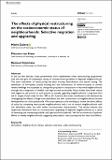Files in this item
The effects of physical restructuring on the socioeconomic status of neighborhoods : selective migration and upgrading
Item metadata
| dc.contributor.author | Zwiers, Merle | |
| dc.contributor.author | van Ham, Maarten | |
| dc.contributor.author | Kleinhans, Reinout | |
| dc.date.accessioned | 2018-06-19T14:30:05Z | |
| dc.date.available | 2018-06-19T14:30:05Z | |
| dc.date.issued | 2019-06-01 | |
| dc.identifier | 252923325 | |
| dc.identifier | f475d353-c0ff-4209-bfae-8939205ce72f | |
| dc.identifier | 85049049071 | |
| dc.identifier | 000474847100010 | |
| dc.identifier.citation | Zwiers , M , van Ham , M & Kleinhans , R 2019 , ' The effects of physical restructuring on the socioeconomic status of neighborhoods : selective migration and upgrading ' , Urban Studies , vol. 56 , no. 8 , pp. 1647-1663 . https://doi.org/10.1177/0042098018772980 | en |
| dc.identifier.issn | 0042-0980 | |
| dc.identifier.other | ORCID: /0000-0002-2106-0702/work/64697493 | |
| dc.identifier.uri | https://hdl.handle.net/10023/14271 | |
| dc.description | The research leading to these results has received funding from the European Research Council under the European Union's Seventh Framework Program (FP/2007-2013) / ERC Grant Agreement n. 615159 (ERC Consolidator Grant DEPRIVEDHOODS, Socio-spatial inequality, deprived neighbourhoods, and neighbourhood effects). | en |
| dc.description.abstract | In the last few decades, many governments have implemented urban restructuring programmes with the main goal of combating a variety of socioeconomic problems in deprived neighbourhoods. The main instrument of restructuring has been housing diversification and tenure mixing. The demolition of low-quality (social) housing and the construction of owner-occupied or private rented dwellings was expected to change the population composition of deprived neighbourhoods through the in-migration of middle- and high-income households. Many studies have been critical with regard to the success of such policies in actually upgrading neighbourhoods. Using data from the 31 largest Dutch cities for the 1999 to 2013 period, this study contributes to the literature by investigating the effects of large-scale demolition and new construction on neighbourhood income developments on a low spatial scale. We use propensity score matching to isolate the direct effects of policy by comparing restructured neighbourhoods with a set of control neighbourhoods with low demolition rates, but with similar socioeconomic characteristics. The results indicate that large-scale demolition leads to socioeconomic upgrading of deprived neighbourhoods as a result of attracting and maintaining middle- and high-income households. We find no evidence of spillover effects to nearby neighbourhoods, suggesting that physical restructuring only has very local effects. | |
| dc.format.extent | 17 | |
| dc.format.extent | 323923 | |
| dc.language.iso | eng | |
| dc.relation.ispartof | Urban Studies | en |
| dc.subject | Urban restructuring | en |
| dc.subject | Neighborhood change | en |
| dc.subject | Selective migration | en |
| dc.subject | Demolition | en |
| dc.subject | GF Human ecology. Anthropogeography | en |
| dc.subject | HT Communities. Classes. Races | en |
| dc.subject | 3rd-NDAS | en |
| dc.subject | SDG 11 - Sustainable Cities and Communities | en |
| dc.subject.lcc | GF | en |
| dc.subject.lcc | HT | en |
| dc.title | The effects of physical restructuring on the socioeconomic status of neighborhoods : selective migration and upgrading | en |
| dc.type | Journal article | en |
| dc.contributor.sponsor | European Research Council | en |
| dc.contributor.institution | University of St Andrews. School of Geography & Sustainable Development | en |
| dc.identifier.doi | https://doi.org/10.1177/0042098018772980 | |
| dc.description.status | Peer reviewed | en |
| dc.date.embargoedUntil | 2018-06-18 | |
| dc.identifier.grantnumber | ERC-2013-CoG | en |
This item appears in the following Collection(s)
Items in the St Andrews Research Repository are protected by copyright, with all rights reserved, unless otherwise indicated.

